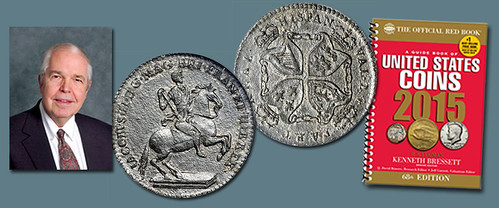
PREV ARTICLE
NEXT ARTICLE
FULL ISSUE
PREV FULL ISSUE
AMERICAN PLANTATION TOKENS
An article this week on the Stack's Bowers blog by Dave Bowers highlights American Plantation tokens. It's part eleven of a
series of posts called A Tour Through A Guide Book of United States Coins. Here's an excerpt. -Editor

Returning to this week’s topic, American Plantation tokens, these were authorized by King James II, who in August 1688 granted a patent or franchise to Richard Holt, an agent who represented the owners of several tin mines. Holt proposed that new issues for the plantations in America be made of tin and be of Spanish monetary designation to facilitate their acceptance in the New World. By that time Spanish-American coins were dominant. The value assigned to these pieces, 1/24th of a real was equal to about 1-1/2 farthings, or somewhere between a British quarter penny and half penny. The dies were cut by John Rottier, one of England’s most famous engravers. In 1964 Eric P. Newman, a leading scholar in the colonial series, created a study for the American Numismatic Society that identified seven obverse and seven reverse die varieties, indicating that the coinage must have been extensive. He was not able to find anything about the distribution, and it is not thought that they were widely circulated in America, although one was excavated in Jamestown, Virginia. The obverse of these tokens shows James II on horseback, surrounded by a Latin inscription. On the reverse are four heraldic shields. Today American Plantation tokens are occasionally encountered, most being restrikes made of Newman die combinations 4-E and the more plentiful 5-D. These were made in a pewter-like metal and not in nearly pure tin like the originals. Originals often display black oxidation called “tin pest” from the metal being subjected to low temperatures. Restrikes sometimes have oxidation, but mostly have bright surfaces. The rims are often irregular. While such pieces can be collected by varieties, most numismatists are satisfied to own one example to illustrate the type. To read the complete article, see:
Wayne Homren, Editor The Numismatic Bibliomania Society is a non-profit organization promoting numismatic literature. See our web site at coinbooks.org. To submit items for publication in The E-Sylum, write to the Editor at this address: whomren@gmail.com To subscribe go to: https://my.binhost.com/lists/listinfo/esylum All Rights Reserved. NBS Home Page Contact the NBS webmaster 
|